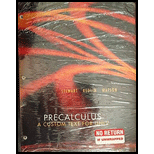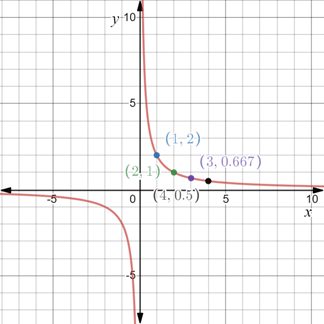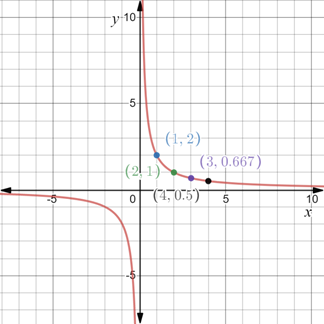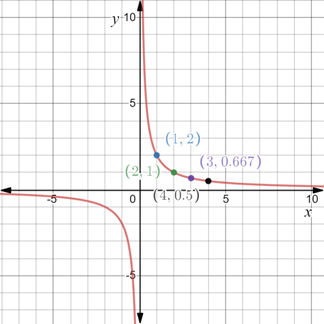
Concept explainers
To calculate: The x- and y- intercepts for the equation
Answer to Problem 67E
There are nox-intercepts and y-intercepts. The equation is symmetric about origin. Graph of the equation is provided below,

Explanation of Solution
Given information:
The equation
Formula used:
The function is symmetric about the x-axis, when y is replaced by
The function is symmetric about the y-axis, when x is replaced by
The function is symmetric with respect to origin, when y is replaced by
The x-intercepts are the points on x-axis where the graph of the equation intersects the x-axis.
The y-intercepts are the points on y-axis where the graph of the equation intersects the y-axis.
Calculation:
It is provided that the equation is
Substitute the point
Substitute the point
Substitute the point
Substitute the point
Construct a table with the values obtained above,
In the coordinate plane plot the points obtained above and connect them through a line.
The graph of the equation is provided below

Recall that the x-intercepts are the points on x-axis where the graph of the equation intersects the x-axis.
Substitute
Therefore, there are no x-intercepts.
Recall that the y-intercepts are the points on x-axis where the graph of the equation intersects the y-axis.
Substitute
Therefore, there are noy-intercepts.
Recall that the function is symmetric about the x-axis, when y is replaced by
Replace y by
The equation is changed. Therefore, the equation
Recall that the function is symmetric about the y-axis, when x is replaced by
Replace x by
The equation is changed. Therefore, the equation
Recall that the function is symmetric with respect to origin, when y is replaced by
Replace x by
The equation is unchanged. Therefore, the equation
Thus, there are nox-intercepts and y-intercepts. The equation is symmetric about origin.Graph of the equation

Chapter 1 Solutions
Precalculus - A Custom Text for UNLV
- Consider the Boundary-Initial Value problem J²u и ди 4 0 0 მე2 It u(0,t) = 0, 0, u(6,t) = 0, t>0 u(x, 0) = x(6x), 0 < x <6 This models a heated wire, with zero endpoints temperatures. The solution u(x,t) of the initial-boundary value problem is given by the series u(x,t)-b, sin П3 n=1 (b, sin ((2n − 1) — x) e-cnt where bn ☐ and Сп ☐arrow_forward• -7 10 1.0 (2 - x) for 0 < x < 2, Let f(x) = for 2< x < 6. Compute the Fourier cosine coefficients for f(x). Ao An Give values for the Fourier cosine series C(x) = = Ao • C(6) = = C(-1) = = C(11) = + n=1 IM 8 An cos пп (π x ). 6arrow_forwardThe Fourier series of the function is given by where со Сп and bn || f(x) = {- 9x if π < x < 0 -4x if 0 < x < π f(x) ~ CO n=0 (Cn cos ((2n+1) x) - Σ bn sin (nx) n=1arrow_forward
- Consider the Boundary-Initial Value problem a²u J²u 9 მე2 Ət²' , 0 0 u(0,t) = 0, u(5,t) = 0, ди u(x, 0) = x(5 − x), at t>0 (x, 0) = 0, 0 < x < 5 This models the displacement u(x,t) of a freely vibrating string, with fixed ends, initial profile x (5 - x), and zero initial velocity. The solution u(x, t), is given by the series ∞ 4 u(x, t) = n=1 bɲ sin (· П (n = 7 x ) cos(cnt) where ཆུ་ང་ and Сп =arrow_forwardThe Fourier sine series of the function is given by 3x f(x) = = if 0x5/3 5 if 5/3 x < 5 where bn b₁ = ☐ ∞ ƒ(2) ~ Σb, sin (n = 2) n=1 (품)arrow_forwardFind the values of a and b for which each function will be differentiable for all values of x on its domain. Note: Please write the answer in the form of ordered pairs (a, b). a² f(x) = x -2b, x ≤-1 b²x,x > −1 2ax²+62arrow_forward
- k. 1. |_ 1/2 S 0 cos(x-2) x3 √1+ e¯x ex dx dxarrow_forwardAttempt 6: 1 out of 2 parts have been answered correctly. Calculate the Taylor polynomials T2(x) and T3(x) centered at x = 7 for f(x) = ln(x + 1). T₂(x) T-(2) - in (8) - (½) (x-7) - (128)(x-7)2 8 Tз(x) = 2(x)+ In(8) + ½ ½ (x-7) - 128 (x-7)² + 1536 (x-7)3 8 Try again Next item Answers Attempt 6 of 6 Ei T The Weather Channel DELL UP % 8 9 205 54 # m E R D F G Harrow_forwardQuestion 3 1 pts By changing to spherical coordinates, calculate A = SSS, e(x²+y²+z²)³/2/2 dV, = 2x and y = where D is the region in the first octant between the planes y = above the cone z = /3(x² + y²), and between the spheres x² + y² + z² and x² + y² + z² = 4. Then sin(4A) is 3x, = 1 0.442 -0.438 -0.913 0.143 -0.502 -0.574 0.596 -0.444arrow_forward
- 2.10 Related rares show me all the correc steps and calculation please DO NOT GIVE ME THE WROTE ANSWER A stone is dropped into a pond, forming a circular wave whose radius is increasing at a rate of 3 inches per second. When the radius is 9 inches, at what rate is the area of the wave growing?arrow_forward2.10 Related rares show me all the correc steps and calculation please DO NOT GIVE ME THE WROTE ANSWER A rectangular screen saver is set up so that its length is always one centimeter more than its height. If the length is increasing at a rate of 2 centimeters per second, at what rate is the area growing when its height is 7 centimeters?arrow_forwardSolve: coshx-1.dx do Sinho + cosho Solve: S Salve dx 4-x2 Solve dx √ex+1 If y = (x² +1). sech (lax), fnd dry. If y = /R/cschx + cothx|, 2nd dyarrow_forward
 Calculus: Early TranscendentalsCalculusISBN:9781285741550Author:James StewartPublisher:Cengage Learning
Calculus: Early TranscendentalsCalculusISBN:9781285741550Author:James StewartPublisher:Cengage Learning Thomas' Calculus (14th Edition)CalculusISBN:9780134438986Author:Joel R. Hass, Christopher E. Heil, Maurice D. WeirPublisher:PEARSON
Thomas' Calculus (14th Edition)CalculusISBN:9780134438986Author:Joel R. Hass, Christopher E. Heil, Maurice D. WeirPublisher:PEARSON Calculus: Early Transcendentals (3rd Edition)CalculusISBN:9780134763644Author:William L. Briggs, Lyle Cochran, Bernard Gillett, Eric SchulzPublisher:PEARSON
Calculus: Early Transcendentals (3rd Edition)CalculusISBN:9780134763644Author:William L. Briggs, Lyle Cochran, Bernard Gillett, Eric SchulzPublisher:PEARSON Calculus: Early TranscendentalsCalculusISBN:9781319050740Author:Jon Rogawski, Colin Adams, Robert FranzosaPublisher:W. H. Freeman
Calculus: Early TranscendentalsCalculusISBN:9781319050740Author:Jon Rogawski, Colin Adams, Robert FranzosaPublisher:W. H. Freeman
 Calculus: Early Transcendental FunctionsCalculusISBN:9781337552516Author:Ron Larson, Bruce H. EdwardsPublisher:Cengage Learning
Calculus: Early Transcendental FunctionsCalculusISBN:9781337552516Author:Ron Larson, Bruce H. EdwardsPublisher:Cengage Learning





